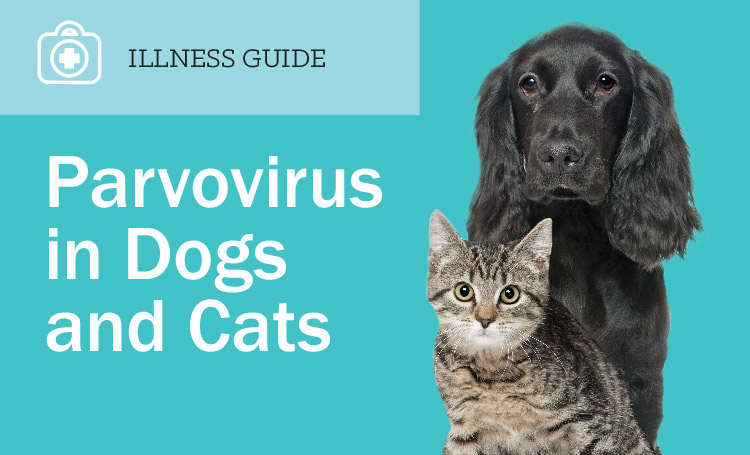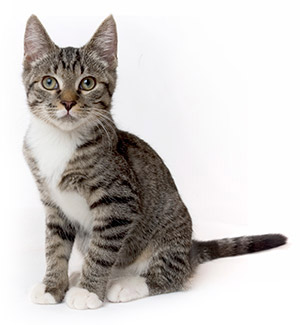
What is Parvovirus?
Parvoviral enteritis is an extremely contagious disease that can threaten the health of your pet, and it is one of the most common viral infections afflicting dogs in the United States today. Though varieties of the parvovirus can infect cats and humans, one variety in particular is the most prevalent and can be transmitted through several different species including raccoons, foxes, wolves, and even domestic cats.
If left untreated, the disease caused by this virus is attributed a 91% mortality rate in infected dogs, though this figure drops to between five and twenty percent when the disease is treated aggressively. Because of the risk parvo poses, it is essential to vaccinate your pet at an early age and to be able to recognize its symptoms in order to keep your animal safe.

Canine Parvovirus
Due to the prevalence of the disease, the only certain way to prevent its spread is to vaccintate your puppy against the CPV2 virus. Some dog breeds are more susceptible to parvo than others- including Rottweilers, Labrador retrievers, German shepherds, Doberman pinschers, and American Staffordshire terriers. There are two types of the virus: CPV1 and CPV2. CPV1 (or canine minute virus) is less threatening than CPV2 and less common, but it can still be fatal in severe cases.
CPV2 comes in three variants, each distinguished by their antigenic patterns. This has made creating an effective vaccination difficult; although, this being said, current vaccinations are working properly and can be the most effective way of preventing the disease. One of the most popular vaccines used to protect dogs is the DA2PPC, which also protects dogs against canine distemper, adenovirus type 1 and type 2, canine coronavirus and parainfluenza.
There are two forms of CPV2: intestinal and cardiac. The intestinal form of CPV2 is more common and can be deadly under severe circumstances or when coupled with a parasitic infestation. The cardiac form is rare but tends to be more fatal.
Causes
Parvovirus is transmitted by contact with either infected fecal matter or an infected environment. The parvovirus can survive on bowls, clothes, carpet and floors and is difficult to remove; it is recommended that exposed areas be treated with bleach to remove the virus completely. The virus is also extremely contagious, so it is very important to make sure that you and your dog do not come into contact with feces and that both of you stay away from environments where there is an infected dog. If you do end up in an environment with an infected dog, it is important to wash your clothes with hot water and bleach to ensure that the virus does not stay on your clothes.
Effects
Intestinal Form
The intestinal form of parvovirus attacks cells that divide rapidly in the lymph nodes, bone marrow and intestinal crypts. Once the white blood cells have been reduced to a trivial number and necrosis occurs in the intestinal crypt, it is likely that the dog will develop systemic inflammatory response syndrome (SIRS). This syndrome leads to intestinal prolapse or to hypercoagulability, both of which can be fatal. Other complications include bacterial myocarditis, which can lead to sepsis.
Cardiac form
The cardiac form begins with necrosis of heart muscle tissue and can occasionally be battled by fibrosis, or the natural scarring of this tissue. On rare occasions, the disease can lead to an infection that causes lesions in tissues throughout the body. On these occasions, it has been known to attack the brain, lungs, kidneys, liver, and adrenal cortex. It can also cause lesions on the lining of your pet's blood vessels, which can lead to hemorrhages.
Symptoms

The most recognizable symptoms of either form of the virus include:
- Vomiting
- Bloody Diarrhea
- Lack of Appetite
- Lethargy
- Fever
- Dehydration
- Anemia
Usually, the first sign of the disease is lethargy followed by diarrhea and loss of appetite. The illness will generally develop over the first three to ten days of exposure. Vomiting and diarrhea might lead to dehydration and heart problems. These symptoms can be fatal if left untreated. Older animals may not show any symptoms aside from dehydration, but dehydration and other symptoms are extremely dangerous and require immediate treatment to ensure the animal recovers completely.
Treatment
Similar to parvovirus in cats, there is currently no known cure that resolutely heals the infected animal. The supportive care available for dogs can greatly decrease the chance of death in infected victims; therefore, identifying the disease early and treating your dog as soon as possible can be vital to your dog's life. Supportive care generally involves hospitalization, the use of intravenous fluids to combat dehydration, and the administration of antibiotics and other drugs to control additional symptoms. The average stay for a dog combating parvo is 5-7 days. This can be quite costly unless your pet has insurance.
Full recovery for adult dogs can take anywhere between five days and two weeks. Puppies generally recover faster, taking only 2 to 3 days. It's important to remember to remove the infected elements from your dog's environment before they return home. When given immediate treatment, 80-95% of dogs fully recover.
Additionally, vaccinations for parvovirus can be given to puppies that are 16 weeks of age or older. After the initial series of vaccinations, a follow up will be needed after one year. If your dog is ever exposed to parvovirus, let your neighbors know so that they can have their dogs vaccinated.

Feline Panleukopenia Virus (FPV)
Feline parvovirus is less common than canine parvovirus, but it can be life-threatening when it afflicts your cat. This virus, also known as the feline panleukopenia virus (FPV) or feline distemper, is closely related to CPV, and it is thought that CPV originally mutated from FPV. Though FPV can be transmitted through raccoons and some species that are closely related to cats, it cannot be transmitted to dogs. FPV can be fatal if it infects your cat, so it's important to understand and recognize the disease it causes to keep your cat safe.
Causes
FPV is highly contagious and thoroughly virulent, so it's important that you do as much as possible to prevent your cat from being exposed to the disease. Parvovirus can remain in an environment for months and is difficult to remove; bleach is the only common household product that will sterilize the virus. FPV is spread through contact with an infected animal or an infected environment. More specifically, it can be transmitted through contact with an infected animal's bodily fluids, feces or by and intermediary vector such as fleas.
Effects
Feline parvovirus damages the gastrointestinal tract and affects the lymphatic system. In cats, cerebellar hypoplasia, an underdeveloped cerebellum at birth, can occur in a litter of cats that were infected with parvovirus in the womb or that were infected in the first two weeks of the kitten's life.
Feline panleukopenia refers to a decrease in the amount of blood cells in your cat, and it can result in a low platelet and cell count. It can also lead to segmental enteritis, or the inflammation of the small intestine. If this leads to septic shock and consumptive coagulopathy, in which small blood clots form throughout an infected cat's system, then the cat will generally not recover.
Symptoms
Feline parvovirus can cause a variety of symptoms, including:
- Vomiting
- Diarrhea that is occasionally bloody
- Inappetence
- Lethargy
- Dehydration
- Anemia
- Malnutrition

Treatment
Unfortunately, there is no known cure for feline panleukopenia, and the disease can be deadly within the first few days of infection. It is, therefore, important to recognize the signs immediately and to get your pet to a vet or animal hospital as quickly as possible. Fluids can be distributed through an IV to battle dehydration, and medication can be administered to prevent seizures. The best thing you can do for an infected cat with a negative prognosis is to offer love and support.
If the cat survives for five days, full recovery is likely but will take several weeks. If your cat is ill, her entire environment should be considered infected until cleaned thoroughly with bleach, though it would be wise to remove some items entirely (litter box, food dishes, toys, etc.). Bedding and other soft items should be washed with bleach in hot water.
We hope this information will help you keep your pets safe in the case of any unfortunate exposure to the disease. For more information, talk to your veterinarian about whether your pet can benefit from any additional vaccinations or booster.


